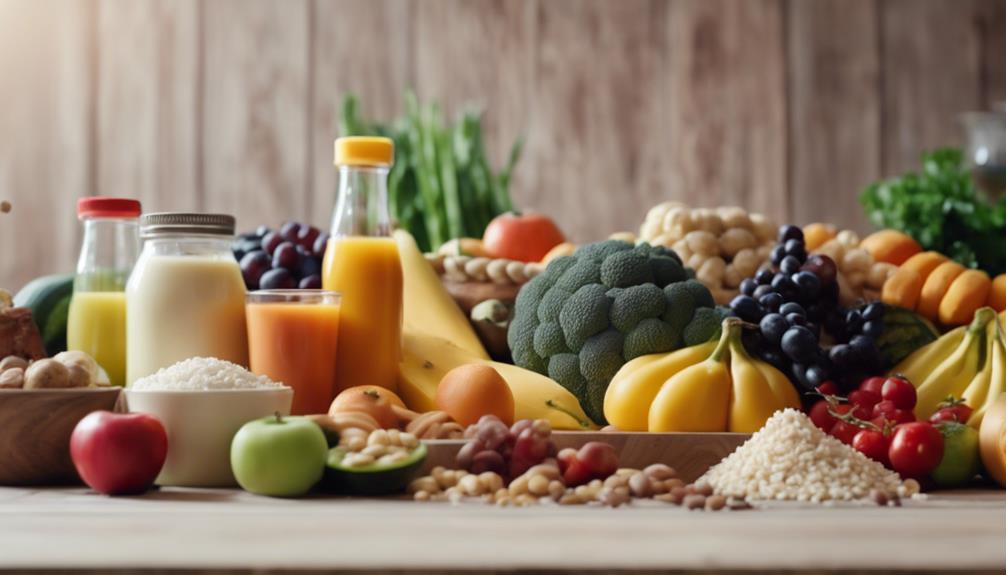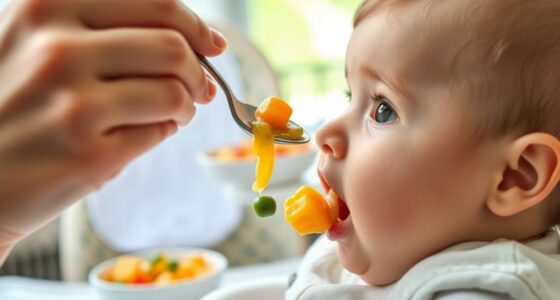To keep mealtimes mess-free while teaching your baby to self-feed, set up a calm, distraction-free environment with a high chair and waterproof mat. Offer small, manageable portions and encourage hand-to-mouth exploration. Use soft, easy-to-grasp utensils and demonstrate techniques to build confidence. Be patient and focus on positive experiences, knowing messes are part of learning. If you keep practicing these tips, you’ll discover more ways to promote independence without the chaos.
Key Takeaways
- Use small, manageable portions and finger foods to promote self-feeding and reduce mess.
- Place a waterproof mat and high chair tray to contain spills and simplify cleanup.
- Demonstrate feeding techniques and encourage imitation to build skills gradually.
- Introduce utensils slowly, starting with easy-to-grasp options and celebrating small successes.
- Maintain a calm, patient environment to foster positive mealtime experiences and confidence.

Mealtimes can often turn into messy battles, especially with curious little ones. As your baby starts to explore self-feeding, you might find yourself constantly cleaning up spills and wiping sticky hands. To make this process easier, it’s essential to focus on effective feeding techniques and a gradual utensil introduction. These strategies help your little one develop independence while keeping the chaos to a minimum.
Mealtimes can be messy, but gentle techniques and gradual utensil learning help your child develop independence.
When teaching your baby to self-feed, start with simple feeding techniques. Use small, manageable portions and encourage your child to pick up food with their hands. This helps build their confidence and coordination. Be patient and provide plenty of encouragement, even if they make a mess. Remember, messes are part of learning. Keep a calm attitude and focus on making mealtimes positive, rather than perfect. Using a high chair with a tray can contain most of the mess, and placing a waterproof mat underneath can catch stray spills. This way, cleanup becomes quicker and less stressful.
Introducing utensils is a vital step in your baby’s self-feeding journey. Begin with soft, easy-to-grasp utensils designed for little hands. Let your baby explore the utensil’s shape and feel, even if they just chew on it at first. Demonstrate how to use the utensil by showing them how to scoop or stab food, and encourage them to mimic your actions. Consistency is key; offer utensils at every meal so your baby becomes familiar with them. Don’t pressure your little one to use utensils perfectly; instead, celebrate small successes to boost their confidence.
As your child gets comfortable with utensils, you can gradually introduce more variety, such as spoons with shallow bowls or forks with rounded tips. Keep in mind that coordination develops over time, and frequent practice helps. To reduce mess, choose utensils with textured grips that help your baby hold on better. Placing the utensil close to the food and guiding their hand initially can also improve their skills. Over time, they’ll learn to scoop, stab, and bring food to their mouth more independently. Additionally, creating a calm mealtime environment can help your baby focus and reduce distractions that might contribute to messiness.
Frequently Asked Questions
When Should I Introduce Self-Feeding to My Baby?
You should introduce self-feeding when your baby shows feeding readiness cues, typically around 6 months, but it varies with teething milestones. Look for signs like grasping food, sitting with support, and showing interest in what you eat. These cues indicate they’re ready to practice. Starting at the right time helps build their skills and confidence, making self-feeding a fun, less chaotic experience for you both.
Which Utensils Are Safest for Babies Learning to Self-Feed?
Choosing the safest utensils for your baby is like finding a needle in a haystack, but it’s worth the effort! Look for options with rounded edges, non-toxic materials, and easy-to-grip handles. Safety considerations include BPA-free plastics, silicone, or stainless steel. These utensil options help prevent injuries and promote independence. Always supervise self-feeding to make certain your little one stays safe while exploring new foods and developing their skills.
How Can I Encourage My Baby to Try New Foods?
You can encourage your baby to try new foods by offering a variety of flavors and textures regularly. Picky eaters often develop with repeated flavor exposure, so keep offering new options without pressure. Make mealtimes fun and positive, and involve your baby in choosing foods. Be patient and consistent; over time, they’ll become more comfortable with new tastes, helping them develop healthy eating habits early on.
What Are Signs My Baby Is Ready to Self-Feed Independently?
You’ll notice your baby shows feeding readiness cues like sitting upright steadily, grasping objects, and bringing food to their mouth. These developmental milestones indicate they’re ready to self-feed independently. Watch for signs like trying to pick up food, using fingers, or showing interest in your food. When these cues appear, it’s the perfect time to introduce self-feeding, helping your baby develop coordination and confidence during mealtimes.
How Do I Handle Messes During Self-Feeding Without Stress?
Imagine mealtime as a beautiful garden that sometimes gets sprinkled with unexpected rain. To handle messes during self-feeding without stress, use simple cleaning techniques like damp cloths and quick wipe-ups. Emphasize mess prevention by setting a tray or placemat, and dress your baby in easy-to-clean clothes. Remember, it’s part of the growth process—embrace the chaos as a sign of their independence blooming.
Conclusion
With these tips, you can turn mealtimes into enjoyable, mess-free moments for both you and your baby. Remember, research shows that 85% of parents feel more confident when their little one learns to self-feed independently. Patience and consistency are key—soon, your baby will master eating skills while you enjoy calm, stress-free meals together. Keep practicing, stay positive, and celebrate each small victory along the way!










